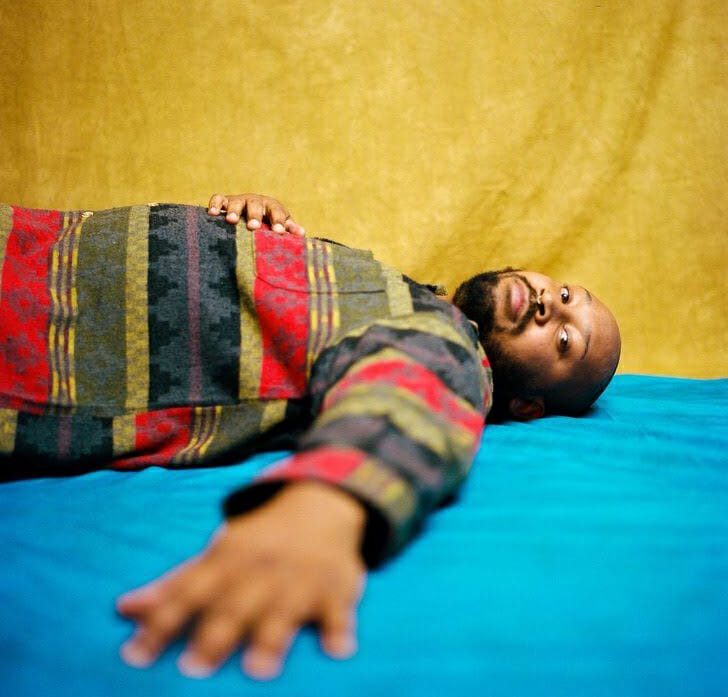
Bartees Strange vividly remembers the first time he saw his father cry. But we’ll get to that in a second.
By the age of 15, the future genre-blurring musician had already spent years bouncing around the country with his dad, a military engineer, and his opera-singer mom—but he was now settled, physically if not mentally, in the small town of Mustang, Okla. Strange didn’t quite fit in one lane: He was a Black, restlessly creative kid in a buttoned-up, largely white town, where he excelled equally at football—he later briefly played at Emporia State University in Kansas—and singing in the church choir. He’d also started experimenting with his own music, which he proudly played for his parents in an attempt to “show them who [he] was.”
“They were pretty religious, and we were in a pretty conservative place,” Strange says. “I didn’t know how to tell them that I didn’t only think girls were attractive, that I didn’t want to just play football forever, that I didn’t want to live in the South anymore. I was a kid, so I didn’t really understand all the things I was feeling. I’d play them songs, almost to tell them a little more about myself. I wanted them to see me as a creative person.”
Which brings us to the waterworks: Strange had just finished playing in a Battle of the Bands, and he eagerly pushed through the crowd, seeking his father’s approval. “I walked over, and my dad was crying,” he recalls. “I was like, ‘Oh, my God. I cracked him!’ I used to write my dad poems for his birthday every year—both my parents. I always tried to elicit emotions from them. I was an emotional kid.”
Almost 20 years later, Strange wields that same command to more sizable audiences. His debut LP, 2020’s Live Forever, was the breakout and the blueprint: Recorded after stints in various bands in Brooklyn, N.Y., and Washington, D.C., the project cemented the songwriter as literally post-genre, fusing tearjerker indie-rock riffs with soulful choruses, trap beats, rapped verses, country strumming and whatever other itches he felt like scratching.
“Before then, I was playing guitar in hardcore bands, country bands, jazz stuff, whatever I could play,” he says. “And I loved it. I was always like, ‘I’d love to bridge [all of ] this.’ I was always dabbling, but I was kind of afraid to go for it because I thought people would think it was corny or didn’t make sense. But eventually, with Live Forever, I was like, ‘I want to hear what it sounds like.’”
A 2022 follow-up, Farm to Table—his first for the venerable 4AD—built on that same anything-goes framework: Propulsive single “Heavy Heart” sounds like The National at their most widescreen, with vocals that dart between morose crooning and dexterous, melodic rapping. But the set was recorded quickly, partly in an effort to build on Strange’s momentum and capture a more natural studio polish.
“I’m like, ‘I think I can make this classic-sheen album,’” he says. “But I’m also a producer, so I want people to know I can make that sound. It’s my résumé. And I know I want the next one to be freaking risky, so it felt good to make something that felt a little safe.”
Speaking of which, Strange— who recently moved to Baltimore—has been working on this mysterious, ambitious[1]sounding third album since before he even finished Farm to Table, tinkering in sporadic bursts with a wide cast of collaborators. “It’s so unlike me to do this,” he says, surveying the long gestation period. “I think I recorded Live Forever in two weeks. I recorded my National project [the 2020 covers EP, Say Goodbye to Pretty Boy] in a week. And I did Farm to Table in like a month and a half. This [next album], I’ve been staring at for two and a half freaking years. [Laughs.] I’m in on this record in a way I’ve never been in on anything.”
It helps, of course, when you have the infrastructure in place to get weird. And that third LP, which he hopes to release in 2024, will take full advantage of all those resources he didn’t have during the Live Forever era.
“The label is supportive, and I’ve got good management,” he says. “All these little tools are in place where I can take bigger risks. And because I’ve toured and met more people, I can ask more people for help that, before, wouldn’t have responded. This next [project] is the world of music I’ve always wanted to make but didn’t have the support, skills or access [to create].”
But even if the album bends genre with even more velocity, it’s coming from a real, organic place—the same sense of curiosity that drove Strange when he was a tearjerking teenager. “It’s like, ‘That sounds good. But I want to try it like this,’” he says, outlining his creative process. “A lot of times, I’ll be listening to a National song, and I’ll start rapping.
It’s like, ‘This shit is hitting like a freaking trap song. I just want to isolate [Bryan] Devendorf’s drums and have Travis Scott rap over them!’ It highlights a deeper truth in the music— all of this is the same shit, and all of it belongs to all of us, and we can do whatever we want with it.”
